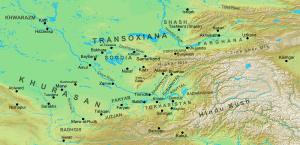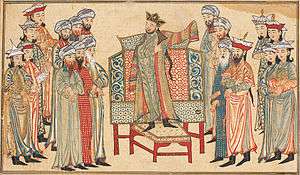Ahmad Maymandi
Abuʾl-Ḥasan al-Qāsim Aḥmad ibn Ḥasan Maymandi (Persian: ابوالحسن القاسم احمد بن حسن میمندی; died 31 December 1032), better known as Ahmad Maymandi (احمد میمندی; also spelled Maimandi), and also known by his honorific title of Shams al-Kufat (شمس الکفاة; "sun of the capable ones"), was a Persian[1] vizier of the Ghaznavid Sultan Mahmud of Ghazni[2] and the latter's son Mas'ud I of Ghazni.[3]
The son of the governor of Bust, Maymandi was raised as the foster brother of the Ghaznavid prince Mahmud, and would first start his administrative career as the head of the department of correspondence of Khorasan. He would thereafter rapidly rise to higher offices, finally becoming the vizier of the Ghaznavid dynasty in 1013, which would last until 1024, when he was arrested due to the great amount of wealth that he had gained, which the suspicious Mahmud disliked.
However, after a brief civil war, which ended in 1030, Maymandi was freed by Mahmud's son Mas'ud I, who offered him the chance of becoming vizier again. He first rejected the offer, but alter accepted in 1031. Maymandi's second vizeriate would only last one year, when he died at Herat. He was succeeded by Ahmad Shirazi.
Biography
Origins and early career
Ahmad Maymandi's father, Hasan Maymandi, was from a town named Maymand in Zabulistan, a region known for its popular traditions about the mythological Iranian warrior Rostam.[5] Hasan was the governor of Bust under Mahmud's father, Sabuktigin, whose kingdom was then a vassal state of the Samanids, who were the lords of Khorasan, and ruled much of the region through their vassals. During Hasan's governorship of Bust, Sabuktigin crucified him, an action which Sabuktigin later regretted.[6] Maymandi was raised as a foster brother to Mahmud[7] and began his administrative career in 994 as head of the department of correspondence during Mahmud's governorship of Khorasan under his Samanid overlords. Maymandi was later promoted to chief accountant and head of the military department. He was also appointed as governor of Bust and Rukhkhaj.[6]
Sabuktigin died in 997, and was succeeded by his son Ismail as the ruler of the Ghaznavid dynasty. Mahmud, who had more administrative experience than his brother, claimed the throne for himself, and the following year managed to defeat his brother and gain control over the Ghaznavid dynasty.[8] Mahmud quickly began increasing his independence from the Samanids, and eventually divided the Samanid state with the Karakhanids, ending the Samanid dynasty.[9]
First vizierate and downfall
The first vizier of Mahmud was a Persian named Abu'l-Hasan Isfaraini, who was chosen by Sebuktegin, although in reality, Mahmud preferred to have Maymandi as his vizier rather than Isfaraini. In 1011, Maymandi was appointed governor of Khorasan and tax-collector of the region. During his governorship, Maymandi was praised by the inhabitants of the region. Two years later, Isfaraini fell from favor and Maymandi was finally appointed as the vizier of Mahmud.[6]

Maymandi quickly began centralizing the Empire, and restored Arabic as the administrative language of the Empire (Isfaraini had made Persian as the administrative language). However, according to the historian Richard N. Frye, Maymandi was not successful in his effort to change the administrative language to Arabic.[10] Ahmad's enemies included Altun Tash, Hasanak Mikali (who later succeeded Maymandi as the vizier of the Empire) and the sister of Mahmud. Among his few supporters were Prince Mas'ud I, Arslan Jadhib, Abu Nasr Mushkan, and probably the former Iranian king Abu Nasr Muhammad, whom Maymandi, in the words of the historian Houtsma, "did all in his power to mitigate the degradation of his fall."[11]
In 1017, Maymandi and Mahmud agreed to invade Khwarazm,[12] then under native Iranian Ma'munid dynasty. According to Ghaznavid sources, the reason for Mahmud's invasion of the region was to avenge the murder of his brother-in-law Ma'mun II, but according to modern sources he used the latter's death as an excuse to expand Ghaznavid rule over the Oxus River.[13] In the same year, the Ghaznavid army deposed the Ma'munid ruler Abu'l-Harith Muhammad, and Altun Tash was appointed as the governor of the region.[13]
During the early 1020s, Maymandi urged Mahmud to invade Jibal, which was then under the control of the young Buyid ruler Majd al-Dawla. However, the real ruler of the region was Majd al-Dawla's mother Sayyida Shirin, which was already known by the neighbors of the Buyids, including the Ghaznavids. Mahmud, however, did not agree with him, and did not feel his empire threatened because of a woman ruling in the region.[14]
In 1024, because Maymandi had gained a great amount of wealth during his career as a vizier, Mahmud removed him from his office, confiscated his property, and had him imprisoned at Kalinjar in India.[15] While the nobles who opposed Maymandi urged Mahmud to execute his former vizier, Mahmud chose instead to spare Maymandi.[6]
Second vizierate and death

When Mahmud died in 1030, the Ghaznavid dynasty fell into civil war; his two sons Mas'ud I and Mohammad Ghaznavi both claimed the Ghaznavid throne. Mas'ud managed to emerge victorious during the civil war, and ordered the release of Maymandi. He met him at Balkh and offered him to become his vizier. Maymandi first refused, but later agreed and began his second career as vizier in 1031. He received full authority over financial affairs and the postmasters and inspectors of the empire.[6] Maymandi then took revenge against some of his enemies, while forgiving the rest of them, including Hasanak, who Maymandi tried but failed to save from getting executed. In the same year, Maymandi approved Mas'ud's decision to appoint Ali Daya as the commander-in-chief of the army of Khorasan.[16] He also appointed Abu Sahl Zawzani as the chief administrator of the army. Maymandi died on 31 December 1032 at Herat, and was succeeded by Ahmad Shirazi as vizier.[17] Maymandi's death was greatly mourned by his supporters, and he was also praised by poets, such as Farrukhi Sistani, who noted the similarities between Maymandi and the celebrated Buyid vizier Sahib ibn Abbad.[6]
Maymandi had a son named Abd al-Razzaq Maymandi, who also gained the vizier office. He also had another son named Sa'id Maymandi, who had a son named Mansur ibn Sa'id who also like Maymandi, occupied high offices.[18]
References
- ↑ Bosworth 2001, pp. 578–583.
- ↑ Bosworth 2011, p. 5.
- ↑ Richards 2014, p. 48.
- ↑ Bosworth 2012.
- ↑ Bosworth 1975, p. 166.
- 1 2 3 4 5 6 Yusofi 1984, pp. 650–652.
- ↑ Nazim & Bosworth 1991, p. 915.
- ↑ Nazim & Bosworth 1991, p. 65.
- ↑ Bosworth, "Mahmud b. Sebüktegin"
- ↑ Frye 1975, p. 145.
- ↑ Houtsma 1987, p. 207.
- ↑ Nashat & Guity 2003, pp. 87–88.
- 1 2 Bosworth 1984, pp. 762–764.
- ↑ Bosworth 1975, p. 177.
- ↑ Nazim & Bosworth 1991, p. 916.
- ↑ Bosworth 1985, p. 853.
- ↑ Bosworth 1975, p. 188.
- ↑ Bosworth 2010, pp. 157–158.
Sources
- Bosworth, C. E. (1975). "The early Ghaznavids". In Frye, R. N. The Cambridge History of Iran, Volume 4: From the Arab Invasion to the Saljuqs. Cambridge: Cambridge University Press. pp. 162–198. ISBN 0-521-20093-8.
- Yusofi, G. H. (1984). "Aḥmad Maymandī". Encyclopaedia Iranica, Vol. I, Fasc. 6. pp. 650–652.
- Houtsma, M. Th (1987). E.J. Brill's First Encyclopaedia of Islam 1913–1936. Brill. pp. 1–299. ISBN 978-90-04-08265-6.
- Bosworth, C. Edmund (1985). "ʿAlī b. ʿObaydallāh Ṣādeq". Encyclopaedia Iranica, Vol. I, Fasc. 8. London et al. p. 853.
- Bosworth, C. Edmund (2001). "Ghaznavids". Encyclopaedia Iranica, Vol. X, Fasc. 6. London et al. pp. 578–583.
- Bosworth, C. E. (2011). The Ornament of Histories: A History of the Eastern Islamic Lands AD 650-1041: The Persian Text of Abu Sa'id 'Abd Al-Hayy Gardizi. I.B.Tauris. pp. 1–169. ISBN 978-1-84885-353-9.
- Richards, D.S. (2014). The Annals of the Saljuq Turks: Selections from al-Kamil fi'l-Ta'rikh of Ibn al-Athir. Routledge. pp. 1–320. ISBN 978-1-317-83254-6.
- Nazim, M.; Bosworth, C. E. (1991). "The Encyclopedia of Islam, Volume 6, Fascicules 107–108". The Encyclopaedia of Islam, Vol. VI. Brill. pp. 1–1044. ISBN 90-04-08112-7.
- Nashat, Guity; Beck, Lois (2003). Women in Iran from the Rise of Islam to 1800. University of Illinois Press. pp. 1–253. ISBN 978-0-252-07121-8.
- Bosworth, C. Edmund (1984). "Āl-e Maʾmūn". Encyclopaedia Iranica, Vol. I, Fasc. 7. C. Edmund Bosworth. pp. 762–764.
- Frye, R.N. (1975). "The Sāmānids". In Frye, R.N. The Cambridge History of Iran, Volume 4: From the Arab Invasion to the Saljuqs. Cambridge: Cambridge University Press. pp. 136–161. ISBN 0-521-20093-8.
- Bosworth, C. Edmund (2010). "ʿAbd-al-Razzāq b. Aḥmad b. Ḥasan Maymandi". Encyclopaedia Iranica, Vol. I, Fasc. 2. London et al.: C. Edmund Bosworth. pp. 157–158.
- Bosworth, C. Edmund (2012). "Maḥmud b. Sebüktegin". Encyclopaedia Iranica.
| Preceded by Abu'l-Hasan Isfaraini |
Vizier of the Ghaznavid Empire 1013 – 1024 |
Succeeded by Hasanak Mikali |
| Preceded by Abu Sahl Hamduwi |
Vizier of the Ghaznavid Empire 1031 – 1032 |
Succeeded by Ahmad Shirazi |
